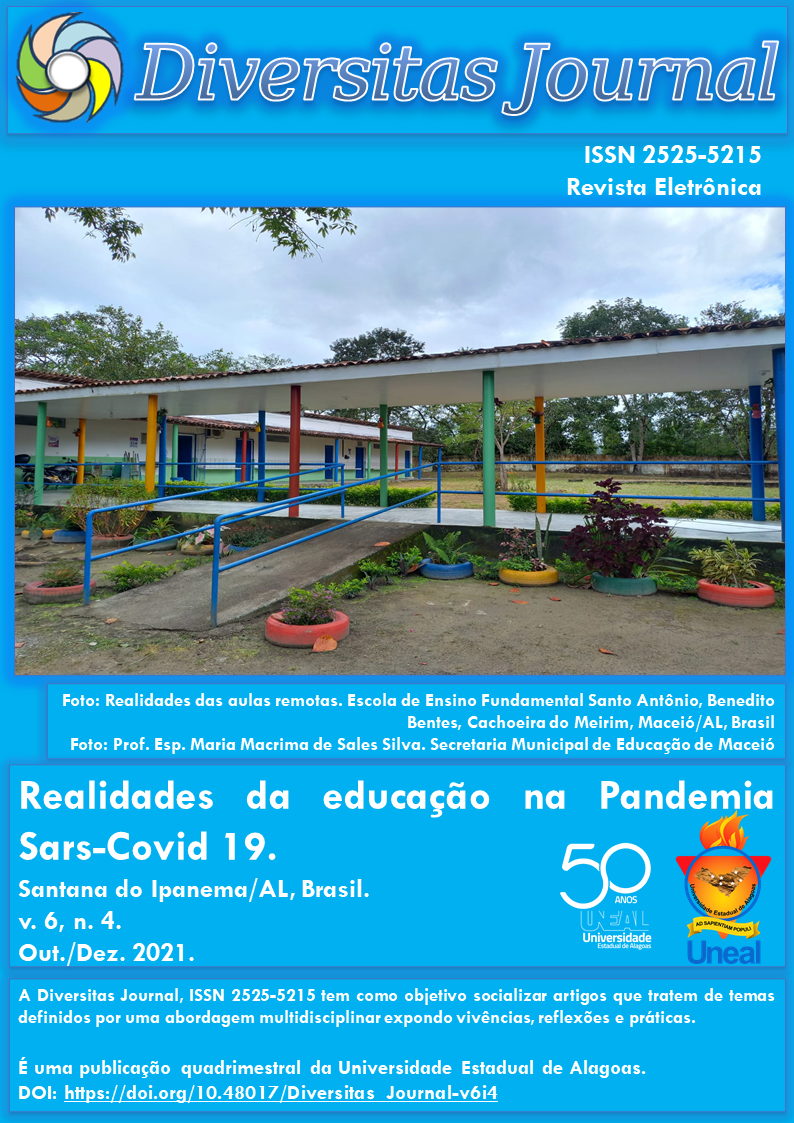Enteroparasites in Lettuce (Lactuca Sativa L.) Marketed at a Free Market in a Municipality of Alagoas
DOI:
https://doi.org/10.48017/dj.v6i4.1451Abstract
: Infections with enteroparasites are among the most frequent infectious diseases in the world, with an estimated number of infected individuals of approximately 3.5 billion people. (CDC 2011, WHO 2011). This study aimed to analyze the presence of parasites in curly lettuce (Lactuca sativa L.) commercialized in the street market in the municipality of Craíbas and to make a comparison between the forms of hygiene and the methods used in the analysis of parasitic structures. This is an observational, quantitative and cross-sectional study. As the municipality has a small fair, 5 stalls out of 10 that sell lettuce were selected in a systematic way, adopting the criteria of yes and no when choosing the collection points; the samples were processed by washing with water, water + detergent + brush, and using the Spontaneous Sedimentation technique (Lutz method) and in the Faust and Cols method, were analyzed, the slide readings were performed under a common optical microscope , under 10X objective and confirmation of parasitic structures in 40X objective. It was observed that the results presented by the modified HPJ method for vegetables and the cleaning of the leaves only with running water as with brush and water with detergent were superior to those obtained in the method of Faust and Cols and in both forms of cleaning, demonstrating less effectiveness in the research of parasitic structures, corroborating the study by Quadros et. al (2008) who presented positive results in the Lutz technique (46.7%) when compared to the techniques of Sheather (31.1%) and Faust (10.6%). Then, based on the data obtained in the present study, the lettuce samples (Lactuca sativa L.), sold at the free market in the municipality of Craíbas-AL, present human and / or animal parasitic forms, thus being an important vehicle for the dissemination of intestinal parasites.
Metrics
References
ALVES, A. S; NETO, A. C.; ROSSIGNOLI, P. A. Parasitos em alface-crespa (Lactuca sativa l.), de plantio convencional, comercializada em supermercados de Cuiabá, Mato Grosso, Brasil. Revista de Patologia Tropical, v. 42 n. 2, p. 217-229.. 2013.
ANTUNES, L. et al. Parasitos em hortaliças comercializadas no sul do Rio Grande do Sul, Brasil. Revista de Ciências Médicas e Biológicas, v. 12, n. 1, p. 45-49, 2013.
ANTUNES, M. A. Contaminação crescimento e inativação de microrganismos na cadeia de produção da alface (Lactuca sativa) Propriedade de Santo Antão - Universidade Federal de Viçosa, Minas Gerais, 2009. pg 30-36.
BARNABÉ, A. S. et al. Análisis comparativo de los métodos para la detección de parásitos en las hortalizas para el consumo humano. Revista Cubana Medicina Tropical. v.62, n. 1, p.21-7, 2010.
BRASIL. IBGE. Cidades: Alagoas: Craíbas 2017. Rio de Janeiro, 2017. Disponível em: https://cidades.ibge.gov.br/brasil/al/craibas/panorama
BRASIL. Ministério da Saúde. Guia de Vigilância em Saúde, 2016. Disponível em: www.saude.gov.br/svs.
Fallah A. A. Prevalence of parasitic contamination in vegetables used for raw consumption in Shahrekord, Iran: influence of season and washing procedure. Food Control. v. 25, n. 2, p. 617-620, 2012.
FALAVIGNA, L. M. et al., Qualidade de hortaliças comercializadas no noroeste do Paraná, Brasil. Parasitologia Latinoamericana, 60: 144-149, 2005.
FERREIRA, E. A. Projeto Educação e Saúde: a importância das medidas de higiene para a profilaxia de doenças parasitárias. Centro Universitário Metodista Izabela Hendrix. Belo Horizonte-MG. 2008.
GHARAVI, M.J. JAHANI, M.R. ROKNI, M.B. Parasitic contamination of vegetables from farms and markets in Tehran. Iranian Jornal Public Health v. 31, p. 83-86, 2002.
HOTEZ, P. J. et al. The global burden of disease study 2010: interpretation and implications for the neglected tropical diseases. PLoS neglected tropical diseases, v. 8, n. 7, 2014.
LI, J. et al., Detection of human intestinal protozoan parasites in vegetables and fruits: a review. Parasites & Vectors, v. 13, n. 1, p. 1-19, 2020.
Massara C. L. et al., Atividade de detergentes e desinfetantes sobre a evolução dos ovos de Ascaris lumbricoides. Caderno de saúde pública, v. 19, p. 335-340, 2003.
MESQUITA, D. R. et al., Ocorrência de parasitos em alface-crespa (Lactuca sativa l.) em hortas comunitárias de Teresina, Piauí, Brasil. Revista de Patologia Tropical, v. 44, n.1, p. 67-76, 2015.
PEDRAZA, D. F. QUEIROZ, D. SALES, M. C. Doenças infecciosas em crianças pré-escolares brasileiras assistidas em creches. Ciência e saúde coletiva, v. 19 n. 02, 2014.
QUADROS, R. M. et al., Parasitos em alfaces (Lactuca sativa) de mercados e feiras livres de Lages - Santa Catarina. Ciências e saúde coletiva, v. 1, p. 78-84, 2008.
SILVA, M. F. F. Caracterização de genótipos de giardia lamblia e ferramentas de educação em saúde como estratégias de prevenção da giardíase. Instituto Oswaldo Cruz. Rio de Janeiro, 2017.
WEGAYEHU T. et al., Prevalence of intestinal parasitic infections among highland and lowland dwellers in Gamo area, South Ethiopia. BMC Public Health. p. 13:151, 2013;
WHO: Soil-transmitted helminth infections 2021. Disponível em: <https://www.who.int/en/news-room/fact-sheets/detail/soil-transmitted-helminth-infections>
Downloads
Published
How to Cite
Issue
Section
License
Copyright (c) 2021 Fernanda de Farias Santos, Israel Gomes de Amorim Santos, Igor Jean Moura da Silva, Dharliton Soares Gomes

This work is licensed under a Creative Commons Attribution 4.0 International License.
The Diversitas Journal expresses that the articles are the sole responsibility of the Authors, who are familiar with Brazilian and international legislation.
Articles are peer-reviewed and care should be taken to warn of the possible incidence of plagiarism. However, plagiarism is an indisputable action by the authors.
The violation of copyright is a crime, provided for in article 184 of the Brazilian Penal Code: “Art. 184 Violating copyright and related rights: Penalty - detention, from 3 (three) months to 1 (one) year, or fine. § 1 If the violation consists of total or partial reproduction, for the purpose of direct or indirect profit, by any means or process, of intellectual work, interpretation, performance or phonogram, without the express authorization of the author, the performer, the producer , as the case may be, or whoever represents them: Penalty - imprisonment, from 2 (two) to 4 (four) years, and a fine. ”


















